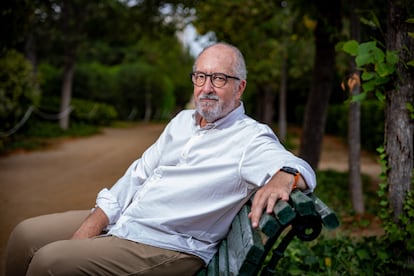‘The risk of food poisoning increases during periods of high temperatures’
José Juan Rodríguez, professor in Food Safety, warns that without changes in the industry and people’s habits, outbreaks of food poisoning will grow

Heat stroke and the increase in mortality associated with periods of high temperatures are not the only risks to public health caused by the climate crisis. Food poisoning is also more frequent when the mercury rises, and this has forced the food industry and the general public to take extreme measures to guarantee food safety. José Juan Rodríguez, professor of Food Safety at the Autonomous University of Barcelona (UAB), insists that there are several factors that increase the danger. One of them is heat, but others are consumers’ preference for foods with fewer preservatives and eating outdoors with food prepared at home or bought at the supermarket that has spent hours outside the fridge.
Question. Is there a link between climate change and food poisoning?
Answer. Yes. Studies show that the increase in average temperature is related to an increase in foodborne diseases, according to official epidemiological bulletins. The number of cases of food poisoning has grown 20% more than expected.
Q. But it’s always been hot, hasn’t it?
A. Yes, but temperatures are changing. There are more and more episodes of high temperatures that last several days, and this triggers the risk of food poisoning. If we do not adjust the entire food chain to them, the number of outbreaks will grow. A good example is salmonellosis. It was typical in southern Europe in the summer months. The Nordic countries were free of it three decades ago. But temperatures have also risen there, and they are now experiencing outbreaks as well.
Q. How exactly are heat and poisoning related?
A. It increases the proliferation of bacteria exponentially. An analysis done in a production plant may not find Salmonella in a food. Perhaps it contains an active bacterium, at a level that is undetectable and is therefore considered safe. If the food is exposed to a temperature of 20 degrees [Celsius], in four hours there will be 10 bacteria, in eight it will be 100 and at 12 hours it will be 1,000. If the ambient temperature is 30 degrees [Celsius], however, the bacteria will be 1,000 in four hours, one million in eight and 100 million in 12.
Q. If the number of bacteria was zero from the beginning, there would be no problems, right?
A. Sure, but that’s not always possible with today’s technology if we want to have food available at a reasonable price. Production is a long and complex chain that starts in fields and farms, continues in factories and distribution centers, and ends in homes, bars, and restaurants. Pathogens are living things that are in the environment and can contaminate food at any point along the chain. The goal is to eliminate them or keep them at safe levels throughout the process.
Q. And how is that achieved?
A. Food producers must follow very strict procedures to avoid, as much as possible, the presence of potentially dangerous microorganisms from source. And in homes, the consumer must follow the usual hygiene and conservation measures shown on the labeling. If something goes wrong, the consequences can be fatal. If the problem is at the source, as happened with listeria in Andalusia [outbreak that caused 221 cases, three deaths and seven miscarriages in pregnant women], the magnitude of the outbreak will be much greater. If you are at home, the number of affected will be smaller. But the risk to the individual is the same.
Q. What went wrong with the Spanish tortilla that caused the recent botulism outbreak?
A. We don’t know, it’s still under investigation. The company has halted production, but tests at the factory had not detected the presence of the Clostridium bacterium that produces the toxin that causes botulism. Perhaps there was a problem, or the bacteria were present below detectable levels. Clostridium has a defense mechanism against unfavorable conditions, and it is not always possible to eliminate them completely. The latter would not be a health risk if the labeling instructions had been followed: keep the omelets in the fridge and heat them for several minutes in the microwave or in a pan before eating them. But we have to wait for the investigations to end. The products have already been recalled. If cases of botulism continue to occur with omelets from other manufacturers, it would indicate that the problem was not in the factory but in some people’s food preparation habits.
Q. What changes do you foresee in the food industry in the future?
A. We have to adapt to climate change. We will find that the heat is a risk that we will have to overcome in the coming years. Legislation and the sector itself will have to make the necessary changes. And the public must be made aware of the importance of following the recommended [food conservation and hygiene] measures. An effort should be made to communicate safe ways to preserve and handle food. People must follow what is indicated on the labels of the food they buy. And this is even more important with some changes that are taking place in the market.
Q. What do you mean?
A. A number of consumers prefer fresh, unprocessed products with fewer additives. Many of these additives are preservatives, which prevent the proliferation of bacteria. It is important to know because then you have to be even more rigorous when following hygiene measures. Food is perfectly safe if the [appropriate safety] measures are followed, but the margin is reduced if something is not done properly at some point in the chain.
Sign up for our weekly newsletter to get more English-language news coverage from EL PAÍS USA Edition
Tu suscripción se está usando en otro dispositivo
¿Quieres añadir otro usuario a tu suscripción?
Si continúas leyendo en este dispositivo, no se podrá leer en el otro.
FlechaTu suscripción se está usando en otro dispositivo y solo puedes acceder a EL PAÍS desde un dispositivo a la vez.
Si quieres compartir tu cuenta, cambia tu suscripción a la modalidad Premium, así podrás añadir otro usuario. Cada uno accederá con su propia cuenta de email, lo que os permitirá personalizar vuestra experiencia en EL PAÍS.
¿Tienes una suscripción de empresa? Accede aquí para contratar más cuentas.
En el caso de no saber quién está usando tu cuenta, te recomendamos cambiar tu contraseña aquí.
Si decides continuar compartiendo tu cuenta, este mensaje se mostrará en tu dispositivo y en el de la otra persona que está usando tu cuenta de forma indefinida, afectando a tu experiencia de lectura. Puedes consultar aquí los términos y condiciones de la suscripción digital.
More information
Extreme heat: A chronicle of the hottest days on the planet
Últimas noticias
Chris Martin, Taylor Swift, Elijah Wood and other famous wedding ‘crashers’
‘How does it feel to be a failure?’: Elizabeth Berkley’s journey from ‘Showgirls’ ridicule to vindication
The story of the Málaga virus: The code that haunted Google’s cybersecurity center director for 30 years
The impact of Ecuador’s mega-prison: A polluted river, cleared forests and military checkpoints
Most viewed
- Christian Louboutin: ‘Young people don’t want to be like their parents. And if their parents wear sneakers, they’re going to look for something else’
- The low-cost creative revolution: How technology is making art accessible to everyone
- All the effects of gentrification in one corner of Mexico’s Colonia Roma
- Liset Menéndez de la Prida, neuroscientist: ‘It’s not normal to constantly seek pleasure; it’s important to be bored, to be calm’
- December Social Security and SSI payments: Dates, double checks and the 2026 COLA increase









































